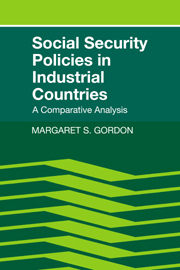Book contents
- Frontmatter
- Contents
- Preface
- Acknowledgments
- Abbreviations
- 1 Postwar developments
- 2 Differences in social security spending
- 3 National old-age pension programs: basic structure
- 4 Other major features of old-age pension programs
- 5 The age of retirement
- 6 Long-term invalidity programs
- 7 Industrial injuries programs
- 8 The role of employer pension plans
- 9 The economic impacts of pension programs
- 10 Health benefits
- 11 Unemployment compensation
- 12 Labor market policies
- 13 Family allowances and family policies
- 14 Public assistance and guaranteed income proposals
- 15 International linkages
- 16 Conclusions
- Appendix 1
- Appendix 2
- References
- Index
13 - Family allowances and family policies
Published online by Cambridge University Press: 06 July 2010
- Frontmatter
- Contents
- Preface
- Acknowledgments
- Abbreviations
- 1 Postwar developments
- 2 Differences in social security spending
- 3 National old-age pension programs: basic structure
- 4 Other major features of old-age pension programs
- 5 The age of retirement
- 6 Long-term invalidity programs
- 7 Industrial injuries programs
- 8 The role of employer pension plans
- 9 The economic impacts of pension programs
- 10 Health benefits
- 11 Unemployment compensation
- 12 Labor market policies
- 13 Family allowances and family policies
- 14 Public assistance and guaranteed income proposals
- 15 International linkages
- 16 Conclusions
- Appendix 1
- Appendix 2
- References
- Index
Summary
Family allowances
Introduction
Family allowance systems are frequently referred to as children's allowance schemes because in most countries the allowance provided to the family is so much per child. However, in a number of countries allowances are also paid for the wife or for a single parent. For this reason, I shall refer to the schemes as family allowances. I also prefer this term because of the growing trend to link family allowances with family policies, which will be discussed in the latter part of this chapter.
Among the countries in this study, the United States alone does not have a family allowance system, and it is unlikely to adopt one in the foreseeable future. All of the other countries do have family allowance systems, but there are vast differences among them – in amounts per child and in other features. The first country to adopt a family allowance system was New Zealand, in 1926, but unlike most of those adopted later, the scheme involved an income test and was designed to assist low-income families. It was not until 1946 that New Zealand's scheme became universal. The Australian state of New South Wales followed with a similar scheme in 1927, a scheme that was replaced by a comprehensive Commonwealth scheme in 1941.
Rather different in their origins were family allowance schemes in France and Belgium. During World War I, under pressure for higher wages to meet rising living costs, more and more French employers turned to children's allowances as an alternative, thus avoiding a rise in general wages but assisting families with children.
- Type
- Chapter
- Information
- Social Security Policies in Industrial CountriesA Comparative Analysis, pp. 282 - 305Publisher: Cambridge University PressPrint publication year: 1989



